Purpose:
For all Ocean Tipping Points project team members to understand common terms used throughout project.
Context:
The concept of ecosystem tipping points, in which an ecosystem can transition with little apparent warning between multiple dynamic states, largely derives from theoretical ecology. This theory has generally not been widely tested in empirical settings, yet there is increasing realization that we are witnessing dramatic changes in ecosystems that may be difficult to reverse. This document, which should be viewed as an evolving ‘working’ draft, focuses on elucidating terminology mostly from theoretical spheres for application to scientific tools for managing ecosystem tipping points in marine systems. Key scientific terms were compiled from a variety of disciplines, including resilience science, climatology, ecosystem science, threshold modeling, and restoration science. For terms with different definitions in different disciplines, we have tried to reconcile conflicting definitions, or explain how the term is used in different disciplines.
Draft Working Definitions1
I. Key terms that build conceptual understanding
•Ecosystem Threshold: A relatively rapid change from one ecological condition to another. This rapid change means that a large ecological response results from a relatively small change in a driver (Bennett and Radford 2003, Groffman et al. 2006, Suding & Hobbs 2009, Huggett 2005). Ecological thresholds exist at all levels of organization, within single populations and species, in species interactions and ecosystem functions/processes, and including wholesale ecosystem regime shifts.
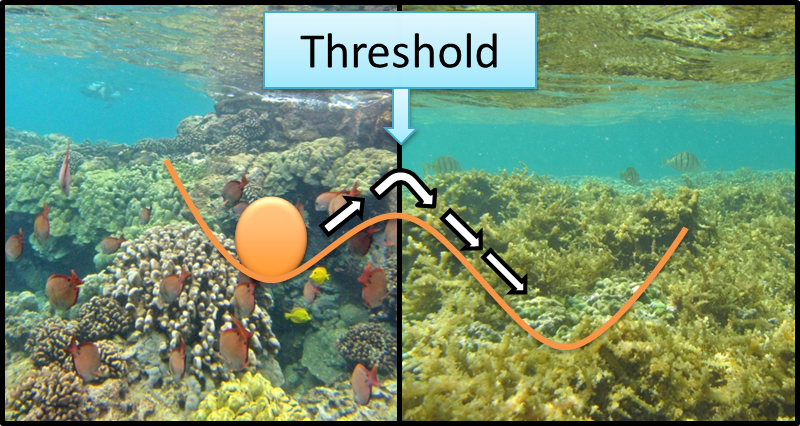
Figure 1. Here an ecological threshold marks the transition from a coral dominated system to an algae dominated system, two regimes that are distinguished by key ecosystem attributes: coral cover, algae cover, and fish species diversity.
• Regime shift: Rapid reorganization of a system from one relatively unchanging state to another (Carpenter & Folke 2006). These distinct and relatively unchanging states are termed regimes and are characterized by a set of governing processes, species composition and relationships among species and to external drivers. The scale and scope of a regime is scale dependent so should be explicitly defined because regimes can be nested in time or space or levels of organization (a concept called panarchy).
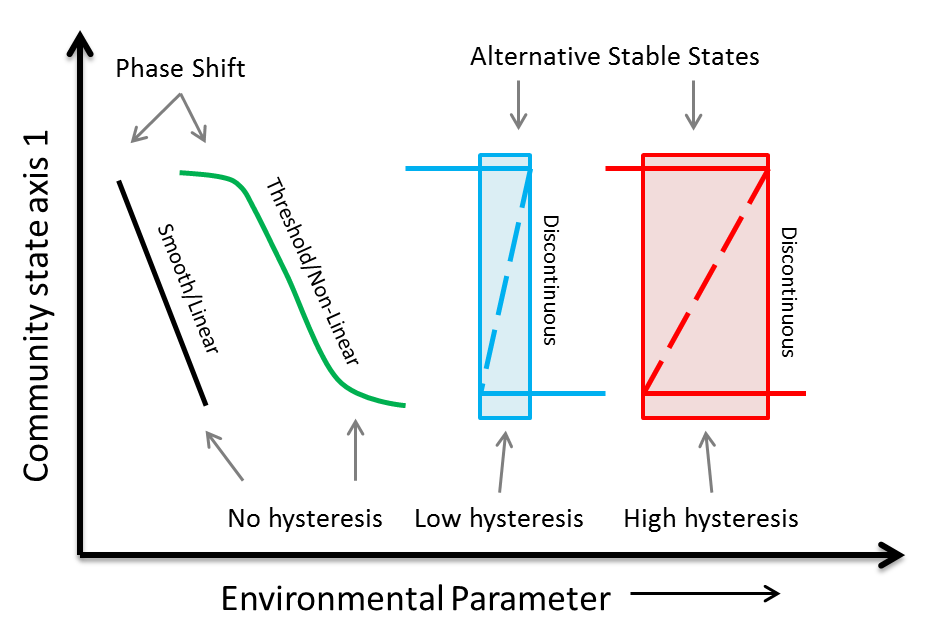
Figure 2. Types of regime shifts. Phase shifts can be smooth or non-linear whereas alternative stable states show discontinuous change with some level of hysteresis. Modified from Dudgeon et al. 2010
Regime is synonymous with basin of attraction. Ecosystem threshold and ecosystem tipping point are general terms also synonymous with regime shift, whereas alternative stable states and phase shifts are particular types of regime shifts (Fig. 2). Three classes of regime shifts, defined by the shape of the relationship between the stressor (driver) and the ecosystem state (biological response) can be distinguished:
- Smooth or Linear- characterized by a linear or nearly linear relationship between the stressor (e.g. fishing effort) and the ecosystem state (e.g. fish abundance) variables (adapted from Lees et al. 2006). Consequently, the threshold boundary between the regimes may be a zone instead of a point and may be hard to ascertain due to the continuous nature of variation in ecosystem state.
- Non-linear- characterized by a non-linear relationship between the stressor and the ecosystem state variables (adapted from Lees et al. 2006). The rate of change in ecosystem state speeds up when crossing the threshold between regimes.
- Hysteretic or Discontinuous- characterized by a non-linear relationship with hysteresis – in which the path from state A to B (degradation) is different from the path from B to A (recovery) and may be very hard to reverse (a.k.a., a critical transition or fold birfucation between alternative stable states; Scheffer et al. 2001, Collie et al. 2004, Lees et al. 2006).
•Ecosystem states and attributes: Ecosystem state is a description and characterization of an ecosystem in terms of key attributes at a particular time. The attributes can be components, functions, processes or properties that aid in defining the ecosystem state and contrasting it to other possible states (Walker et al 2002; Suding & Hobbs 2009). For example, if a rangeland system is defined by the amounts of grass, shrub and livestock, then the ecosystem state is the value of these attributes at a particular instant in time. Although this description acts as a “snapshot” in time, dynamic processes and trajectories of change may be integral to understanding an ecosystem’s state. In practice, one would distinguish two states only if the difference between them represented an important change in the ecosystem from the point of view of management (Westoby et al. 1989). In theoretical terms, the attributes are called state variables and conceptualized as axes in a multi-dimensional state space of all possible combinations of the amounts of these three variables (Suding & Hobbs 2009). As explained further below (see Attractor) a dynamic system moves through the state space in non-linear ways. While ecosystem state is sometimes used synonymously with regime, we recognize that there may be multiple states within a single regime, e.g. a state of low resilience close to a regime shift vs. a state of high resilience far from a regime shift.
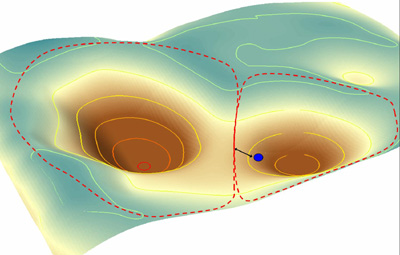
Figure 3a. This three-dimensional stability landscape shows two basins of attraction, in one basin, the current position of the system is represented by the blue ball (defined again by the current amounts of grass, shrub and livestock for example). As long as the ball is in the basin, the system is in that regime. The system (or ball) tends to move to the bottom of the basin, which acts as the attractor where the system is in an equilibrium state. Figure from http://www.resalliance.org/index.php/key_concepts
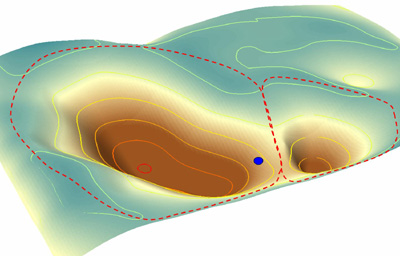
Figure 3b. One way that an ecosystem can transition to a new state is when external forces change the shape of the stability landscape itself (a.k.a shifts in parameter values, see Fig. 4b). Here, the basin of attraction that the system was in shrunk and an alternate basin expanded, pushing the ball upwards over the lip instead of the ball moving laterally (from Walker et al. 2004). The dotted line acts as the critical transition between alternate attractors -- once crossed, the system will tend towards a different equilibrium. Figure from http://www.resalliance.org/index.php/key_concepts
•Attractor and basin of attraction: As explained in the definition for Ecosystem State, a dynamic system moves through a multi-dimensional state space whose axes are key attributes of the ecosystem. Constraints on this movement are conceptualized as peaks and valleys of state space (Fig 3a). A basin of attraction (a.k.a regime) is a valley in which the ecosystem tends to remain due to negative feedbacks in the system that dampen change. The lip of the basin corresponds to the threshold, the walls of the valley correspond to rapid change, and the depth of the valley corresponds to the stability of the conditions or conversely, the amount of perturbation that would be needed to shift the system into an alternative state, i.e., a different basin. For systems that tend toward an equilibrium state, the equilibrium state is defined as an “attractor,” and the basin of attraction constitutes all initial conditions that will tend toward that equilibrium state (Walker et al. 2004). Multiple basins of attraction are defined by different combinations of ecosystem attributes (e.g., amounts of grass, shrubs, and livestock toward which a rangeland might tend, depending on the starting point).
•Ecosystem stability/stable state: The propensity of a system to remain in a constant state with respect to measured ecosystem attributes, and to return to that state following minor perturbations. Stability is often characterized as persistence of a system near or close to an equilibrium state and is conceptualized as a stability domain or a basin of attraction (Holling 1973, Gunderson 2000, Folke et al. 2010).
Example: If a weight is added suddenly to a raft floating on water, the usual response is for the weighted raft to oscillate, but the oscillations gradually decrease in amplitude as the energy of the oscillations is dissipated in waves and, eventually, in heat. The weighted raft will come to rest in a different position than the unweighted raft, but we think of the new configuration as essentially the same as the old one. The system is stable.
Suppose that a fixed weight is placed on top of an occupied raft. If the occupants of the raft move about, the raft may float at a slightly different angle, but if they move too far or all at once, the raft may tip. The range of possible movements of the occupants that do not lead to tipping is called the domain of stability, or domain of attraction, of the upright state. If the amount of the fixed weight is gradually increased, the balance becomes more precarious and, hence, the domain of attraction will shrink. Eventually, the weight becomes large enough so that there is no domain of attraction at all, and the raft will flip over no matter what its occupants do. From Ludwig et al. 1997.
•Safe Operative Space: Ecosystem limits set within precautionary buffers within which the risk of unwanted regime shift is low and resilience is high
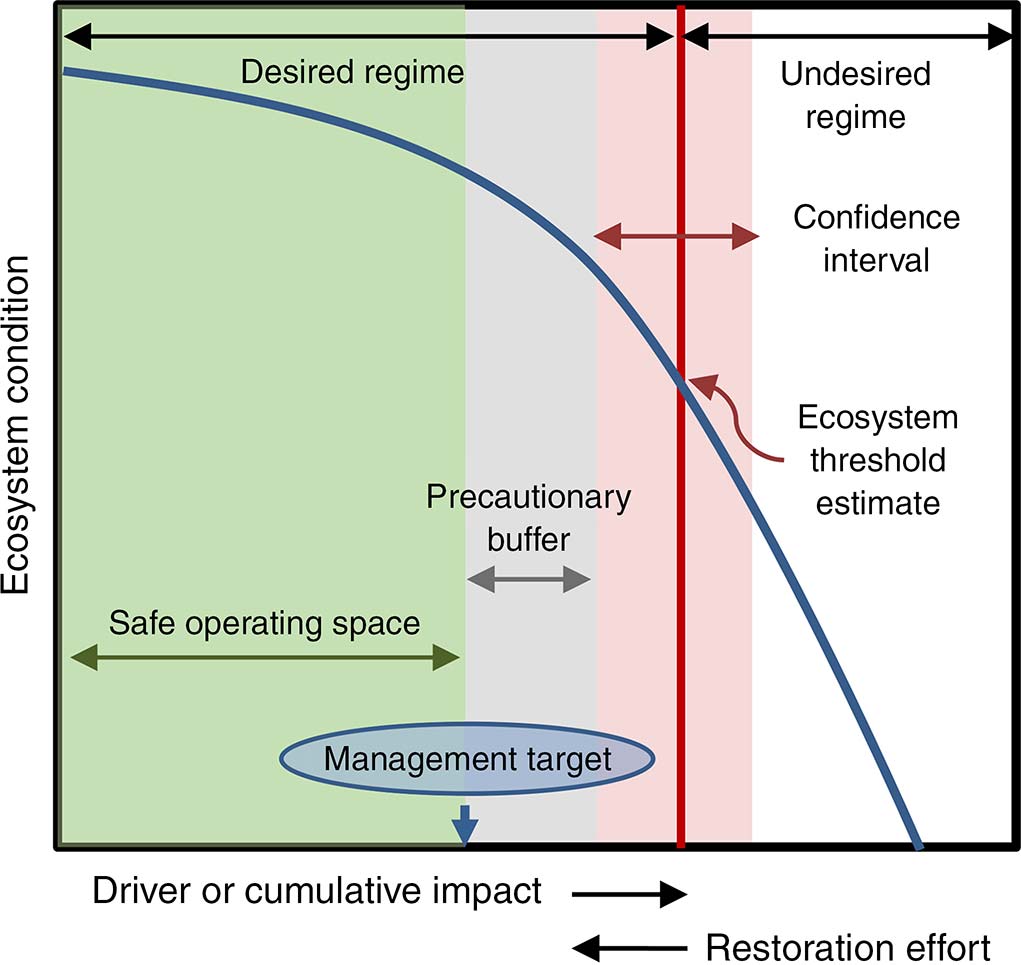
•State Variables vs. Parameters: Ecosystem attributes are defined state variables and parameters that primarily constitute the ecosystem of interest (Suding & Hobbs 2009). Variables are quantities that change “quickly” in response to feedback from model dynamics – they are involved in or sensitive to internal feedbacks of the system; parameters are quantities that are either independent of, or subject only to very slow feedback from state variables within the model (Beisner et al. 2003); they are often external to the system. For example, if fishing is applied with constant effort, it is subject to feedback from the system (catch goes down when fish are scarce) and can be considered a variable like other predator-prey processes. However, when technology enhances fishing effort and keeps catch high despite fish stock depletion, fishing is better viewed as a parameter external to the system (modified from Beisner et al. 2003). Another way that variables and parameters have been contrasted in the literature is that variables of a system are measurable ecosystem state characteristics (e.g. population density) while parameters are the drivers of these state variables (e.g. birth/death rates, migration, etc.) (Beisner et al. 2003). Changes in either variables or parameters can lead to regime shifts (Fig. 4).
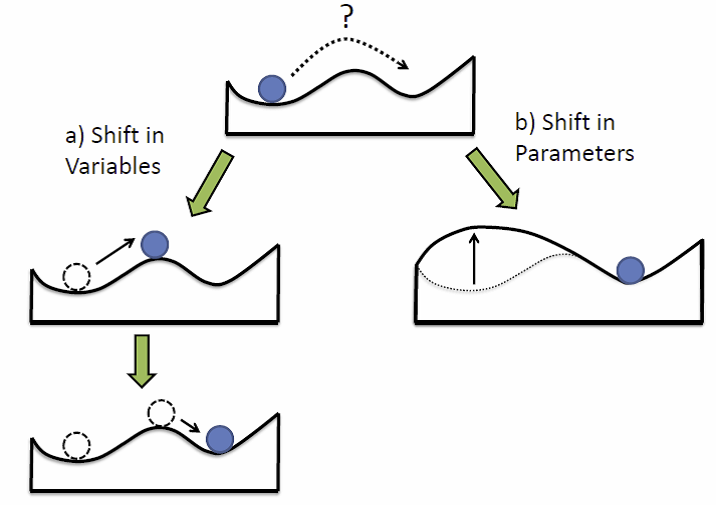
Figure 4. Two-dimensional ball-in-cup diagrams. Here again the ball represents the current position of the system (e.g. by the current amounts of grass, shrub and livestock) and the cup represents the basin of attraction; (a) a shift in state variables causes the ball to move laterally, (b) but a shift in parameters causes the landscape itself to change, moving the ball vertically (from Beisner et al. 2003; see Fig. 3b for another way to illustrate 4b).
•Tipping point: The colloquial/loose synonym of threshold -- a generally well-understood concept for communication with a broad audience that captures the non-linear and dramatic change associated with thresholds.
II. Alphabetical list of supporting terms
•Adaptive Capacity: An aspect of resilience most often applied to coupled social-ecological systems (SES) that captures learning, flexibility to experiment and adopt novel solutions, and development of generalized responses to broad classes of challenges (Walker et al. 2002), all of which expand the range of variability with which the system can cope (Adger 2006). More generally, adaptive capacity is the ability of any living system to adjust responses to changing internal demands and external drivers (Carpenter & Brock 2008)
•Alternative Stable States: When a single set of abiotic and biotic external conditions supports two or more different stable ecosystem states separated by an unstable threshold. In theoretical terms, multiple basins of attraction (a.k.a. states) exist within a system (Suding & Hobbs 2009).
•Critical Transition: A theoretical term referring to a specific type of threshold in which a system passes a bifurcation between alternate attractors (as in Fig. 3a). The shift is driven by positive feedbacks creating a runaway change to the alternate attractor/state (Scheffer 2009).
•Critical slowing down: A phenomenon wherein the system becomes very slow in recovering from perturbations, which is an indicator of approach to a critical transition (Scheffer 2010).
•Driver: A force of change. Stressors or pressures have associated drivers that indicate the mechanism(s) involved in initiating a course of events. According to ecological usage, any force associated with any natural or anthropogenic process, event or activity that causes a change in an ecosystem process, component, function, property or service. For example, coastal development is a stressor associated with increased sedimentation on reefs, which is a driver of coral mortality contributing to an ecosystem shift to algal-dominance. Note that the (Driver-Pressure-State-Impact-Response (DPSIR) framework uses a very specific definition of driver: a fundamental social process, such as the distribution of wealth, which shapes the human activities that have a direct impact on the environment (Carr et al. 2007). In the former, activities have associated drivers that cause specific changes to an ecosystem; in the latter, drivers result in activities that may impact the ecosystem.
•Dynamic regime: A set of alternative stable states, or simply a system that exhibits threshold dynamics between 2 or more ecosystem states (Suding & Hobbs 2009).
•Ecosystem service: the goods and services provided by ecosystems that generate benefits to people (Granek et al. 2009). “Ecosystem services are the benefits people obtain from ecosystems. These include provisioning services such as food, water, timber, and fiber; regulating services that affect climate, floods, disease, wastes, and water quality; cultural services that provide recreational, aesthetic, and spiritual benefits; and supporting services such as soil formation, photosynthesis, and nutrient cycling.” {Reid et al. 2005 page V.}
•External conditions: Factors that affect but are not notably affected by the system over timescales relevant to the analysis at hand.
•Feedback: An ecological process that either reinforces or degrades the resilience of a stable state (Briske et al. 2006). Positive feedbacks amplify the amount of change the system will experience in response to a small perturbation, whereas negative feedbacks dampen the effects of perturbations, counteracting the change (Fig. 5; Suding & Hobbs 2009).
•Feedback switch: A shift from negative to positive feedbacks that initiates threshold occurrence; the switch is induced by a ‘trigger’ event (Fig. 5; Briske et al. 2006).
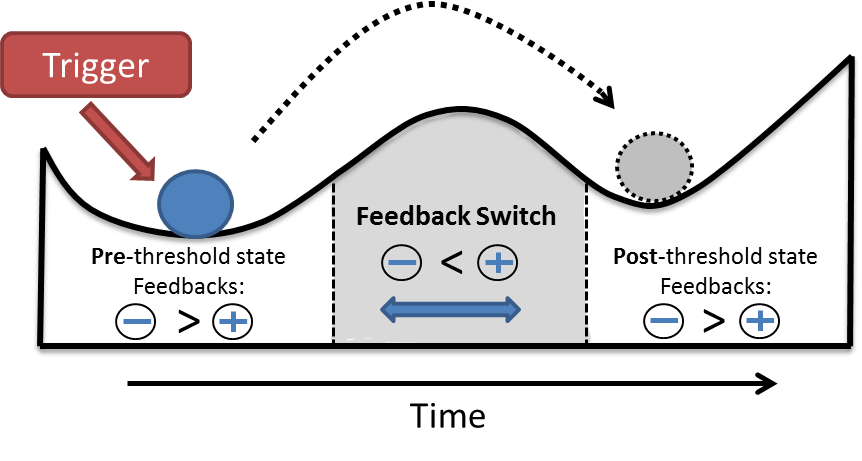
Figure 5. How a feedback switch (shaded region) creates a threshold occurrence. Thresholds are the point at which feedbacks switch from a dominance of negative feedbacks (-) that maintain resilience of the pre-threshold state (solid ball) to a dominance of positive feedbacks (+) that decrease resilience of the pre-threshold state and enable an alternative post-threshold state (dashed-line ball). Triggers represent events that initiate the feedback switch and push the ball into an alternative stable state (adapted from Briske et al. 2006).
•Flickering: Conspicuous fluctuations from one ecosystem state to the other across a threshold (Carr et al. 2012). The behavior indicates the existence and location of the threshold and is considered an early warning, or leading indicator, that the ecosystem state is near a threshold. In theoretical terms, the threshold is a catastrophic bifurcation between two alternate basins of attraction, and is flanked by a bi-stable region, also known as a ‘saddle’, encompassing the adjacent edges of the two basins. When stochastic forcing is just strong enough to place the system in the bi-stable saddle region, the system is easily provoked back and forth across the bifurcation, causing flickering. (Drawn from Scheffer 2009). Flickering is measured by tracking the variance and skewness of state variables through time.
•Hysteresis: When the pathway of recovery of an ecosystem differs from its pathway of degradation (Suding & Hobbs 2009); path dependence (Fig. 6). Hysteresis is a concern when the pressure which caused a system to degrade past a threshold has been removed but the system does not recover (Montefalcone et al. 2011), indicating that although the pre-threshold conditions have returned, the system remains in an alternative state. Thus, two alternative states are possible under the same external environmental conditions.
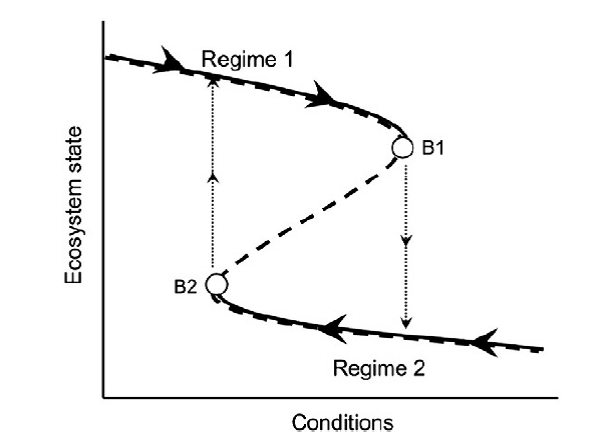
Figure 6. Hysteresis is illustrated graphically by depicting path dependence along a trajectory of change in ecosystem state. If the system is in regime 1 close to bifurcation point B1, an incremental change in conditions may induce an discontinuous shift to the alternative state, or regime 2 (down arrow). If one then tries to restore regime 1 by reversing the conditions, the system shows hysteresis. A return shift to regime 1 only occurs if conditions are reversed far enough to reach the other bifurcation point, B2 (up arrow). Based on Scheffer et al., 2001.
•Indicator (of a threshold): A specific, well-defined, and measurable variable tracked through time which can communicate changes in ecosystem condition and provide an estimate of the location of an ecosystem in state space relative to a threshold (Heinz Foundation 2008). Indicators simplify information about complex phenomena to improve understanding (King 1997).
•Leading: Measurements of a system that provide early warning of an event (in this case, threshold). They may focus on drivers and pressures that are expected to shift a system toward a threshold, instead of internal components of the ecosystem (Herrera & Hovden 2008). Leading indicators are not necessarily good proxies for the changes taking place, but provide clues about the future (King 1997). In the context of regime shifts, suggested leading indicators that warn of an impending ecosystem shift include increased autocorrelation, rising variability, and ‘flickering’ between alternate ecosystem states.
•Lagging: Measurements of a system that are taken after events, which indicate outcomes, results and occurrences. They should attempt to provide a signal of the key changes in system interactions following the threshold (Herrera & Hovden 2008). For example, when measuring management performance, a lagging indicator would measure the number of times a threshold was crossed.
•Phase shift: In ecology, it refers to a marked change in community structure (Mumby et al. 2013). A phase shift is a change in the ecosystem state in response to a persistent change in external environmental conditions, therefore there is only one stable state within these systems under the same external conditions (Dudgeon et al 2010). A phase shift is not a shift between ‘alternative stable states,’ which specifically requires >1 configuration of the biological community under the same external conditions (Fig. 2).
•Pressure (from the DPSIR model): Both the specific human activities connected to drivers which impact the environment, such as resource extraction, and the natural processes that have a similar impact on the environment, such as volcanoes and solar radiation (Carr et al. 2007).
•Reference point: A value of an indicator associated with a particular ecosystem state or condition that is often used to quantify management objectives. A related term is a reference direction: the directional trend of an indicator relative to the focal state.
•Target reference point: a value management aims to achieve (i.e., a socially desired ecosystem state, zone or point) based on management goals. A target expresses a goal in quantitative, measurable terms that can be practically evaluated; e.g., the goal is swimmable water, the target is a maximum E. coli level.
•Limit reference point: a value management aims to avoid. e.g., if the goal is sustainable fisheries, the limit might be a maximum fishing mortality or minimum fish biomass values.
•Baseline reference point: a value associated with “initial” conditions, which needs context-specific definition. e.g. pre-industrial level biomass
•Resilience: The capacity of an ecosystem to absorb perturbations while retaining its essential structure, function and feedbacks (i.e., stay in the same state, not cross a threshold) (Suding & Hobbs 2009, Folke et al. 2004). Speed of recovery following perturbation is a common empirical metric of resilience. Ecosystem resilience is the capacity of an ecosystem to tolerate disturbance without crossing a threshold into a different regime (Resilience Alliance - http://www.resalliance.org/index.php/resilience)
Example: The key to resilience in social-ecological systems is diversity. Biodiversity plays a crucial role by providing functional redundancy. For example, in a grassland ecosystem, several different species will commonly perform nitrogen fixation, but each species may respond differently to climatic events, thus ensuring that even though some species may be lost, the process of nitrogen fixation within the grassland ecosystem will continue. From Resilience Alliance- http://www.resalliance.org/index.php/resilience.
•Stressor: A synonym for Pressure.
•Trigger: A temporary perturbation that can have long-term repercussions (Suding & Hobbs 2009). Specifically, triggers are perturbations that initiate threshold-related processes by shifting the relative strength of balancing (i.e., negative) and reinforcing (i.e., positive) feedback loops (Meadows 2008) that maintain or erode state resilience, respectively (Fig. 2; Scheffer & Carpenter 2003, Briske et al. 2006). While drivers can impact triggers, drivers are distinct from triggers.
•Vulnerability: The susceptibility of a system to harm or loss, due to exposure to—and sensitivity to—a specified pressure (Turner et al. 2003, Chapin et al. 2009). Conceptually similar to resilience in that it characterizes the system’s adaptive capacity, sensitivity to change, and ability to cope and recover, but unlike resilience, also includes consideration of the degree of exposure to specific threats.
Please see References
1Note: This is a working draft pending input from project science and management advisory groups. The scientific terms were compiled from a variety of disciplines, including resilience science, climatology, ecosystem science, threshold modeling, and the ecosystem states literature. For terms with different definitions in different disciplines, we will
- Work to reconcile conflicting definitions to come to a common definition of a term when possible, or
- Identify terms whose definitions cannot be reconciled and have a common understanding of how the term is used in different disciplines.
